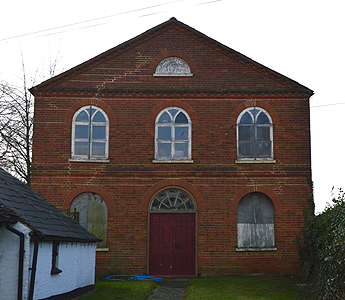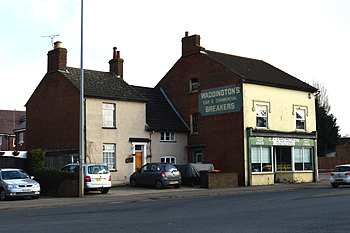Congregationalism in Hockliffe

The former Congregationalist chapel February 2013
According to H. G. Tibbutt in his 1959 booklet Hockliffe and Eggington Congregational Church 1809-1959, on which this article is largely based, the foundations of Hockliffe Congregational Church were laid by the Rev. Michael Castleden of the Independent Chruch at Woburn who preached at Hockliffe at the beginning of the nineteenth century. In 1806 the house of William Read at Hockliffe was licensed as a meeting place for Dissenters and it seems likely that this was the first home of the Hockliffe Independents. Another 1806 sources states that on 20th May "after a few weeks village preaching by some of the neighbouring ministers, a place was fitted up and opened at Hockliffe, Bedfordshire … The prospect is highly encouraging after a long night of darkness; but at present the place is only occasionally supplied by a few ministers who reside in the neighbourhood".
The first resident minister, Rutton Morris, probably arrived in 1808. In 1809 a barn came into use as the regular meeting place for the congregation and on 20th December 1809 a Church Covenant was drawn up and subscribed to by Thomas Willis, Francis Jennings, Thomas Saunders and Francis White. Numbers increased and a gallery was added to the building before July 1812. As a missionary church the Toddington Independent Chapel (which later became Baptist) was founded from Hockliffe. Discipline was strict and on 2 June 1820 Mrs. Cox of Tebworth was suspended from the Ordinance "in consequence of a very unsuitable marriage to a person who made no pretence to religion and who did not bear a good character".
The original chapel became too small and early in 1824 an appeal was launched for funds to build a new chapel. This was built in 1825 at a cost of £566.12s.11d; accounts show that 62,000 bricks were used in its construction. It was said of the minister Thomas Hitchin that: "by [his] zeal a new and commodious building was erected for which he collected some hundreds of pounds. To obtain this sum he visited several of our principal towns, as well as the metropolis, waling many weary miles and shrinking from no fatigue or discouragement till the task was accomplished. The place, however, was so poor and his salary so small, that had it not been for a flourishing school which his daughters conducted, he could not have lived." Along with the new chapel an Independent burial ground was opened.
A list of church members for 1831 shows that there were 54 members, of whom 31 were from Hockliffe and 15 from Eggington. A gallery was added to the chapel in 1834 and other improvements carried out. In 1840 a new Independent chapel was opened at Eggington in association with Hockliffe. On Sunday 30th March 1851 a census of all churches, chapels and preaching-houses of every denomination was undertaken in England and Wales. The local results were published by Bedfordshire Historical Records Society in 1975 as Volume 54, edited by D. W. Bushby. The return for Hockliffe Independent Chapel was made by the minister, James Sleigh. The meeting had 120 free seats and 120 others. The general congregation was 64 in the morning and 47 in the evening, with 30 Sunday Scholars in the morning and 10 in the evening. Average attendances for the preceding twelve months were 65 adults and 35 scholars on Sunday mornings and 45 adults and 10 scholars in the evening.
The church also provided education for adults. The Hockliffe Mutual Improvement Society met from 6.30pm-8.30pm and taught "writing, arithmetic, addresses on history, biography, grammar, morals – broad, unsectarian religious truths, natural and revealed, etc". Both teachers and students paid one penny each month; there were 11 male teachers, 25 male students (including 19 farm labourers), and 21 female students (including 17 straw plaiters). A library was set up from which the congregation could borrow books which in 1855 had a stock of 59 books.

The Old Manse and C A Waddington February 2013
In the 1850s the Government tightened the rules for burial grounds and an Order of 7 December 1855 ordered the discontinuance of burials in the Wesleyan and Independent burial grounds at Hockliffe and burials at the Independent chapel ceased from 1 July 1857. In 1858 a manse was provided for the new minister, Ref. J. Roome Smith, incurring a debt which took until the late 1870s to pay off. The membership in the 1870s stood at 40, but by 1901 the Bedfordshire Union of Christians was commenting that "the friends at Hocklfife and Eggington have very uphill work and it seems a pity that there cannot be one united Church for these villages". In 1913 the Congregational Church closed and the chapel was let to the Hockliffe Primitive Methodists whose own chapel was in a poor state. The Bedfordshire Union Report for 1913 stated: "It has been decided not to continue the work of a Congregational Church at Hockliffe. Adverse circumstances extending over many years, have made this step advisable and in these days of co-operation and growing impatience at the foolish overlapping of Free Churches in circumscribed areas, it is some consolation to know that the premises are not be closed to Public Worship but are being used by the existing Primitive Methodist Church under the care of the Leighton Buzzard Circuit".
This was not the end of the story for the Congregationalists in Hockliffe. At the Executive Committee of the Bedfordshire Union on 21 January 1920 the Secretary reported that "the members worshipping in the Congregational Church premises are severing their connection with the Leighton Buzzard Primitive Methodist Circuit in March and are desirous of becoming a Congregational Church". The revived Congregational Church was again served by a minister jointly with Eggington until 1926, after which it was served by lay preachers until the ministers of Dunstable Congregational Church took it under their wing in 1949.
The Hockliffe Congregational Church closed for the second and presumably final time sometime after 1959 and was empty for many years. The building was given Grade II listed building status in 1980. The listing describes it as being of red brick with a slate roof, a pediment, and modillion brick eaves. There are three casement
windows with circular heads to the first floor, a first floor band, two sash windows
with glazing bars to the ground floor, and double doors with a fanlight. The chapel was put up for sale in 2013 with planning permission for change of use from a place of worship to residential. The proposed floor plan shown on the sale particulars included a vaulted living room, kitchen/breakfast room with separate utility room, study, downstairs cloakroom, 2 double bedrooms each with en-suite, first floor conservatory and terrace [Z449/6/46].
Ministers of Hockliffe Congregational (Independent) Church:
- Rutton Morris, 1808-1821;
- Thomas Hitchin, 1822-1830;
- James Raban, 1833-1838;
- William Lewis, 1839-1845;
- James Sleigh, 1846-1857;
- J. Roome Smith, 1858-1861;
- David Waters, 1865-1873;
- William D. Attack, 1873-1877;
- George Grant, 1877-1882;
- Edward Allen, 1888-1890;
- F. W. Bradford, 1891-1893;
- Frederick Brasier, 1898-1899;
- Joseph Pearson, 1906-1908;
- Alfred Barratt, 1908-1910;
- W. J. Workman, 1920-1926;
- Charles R. Bruford, 1949-1956;
- George E. Hooper, 1957-